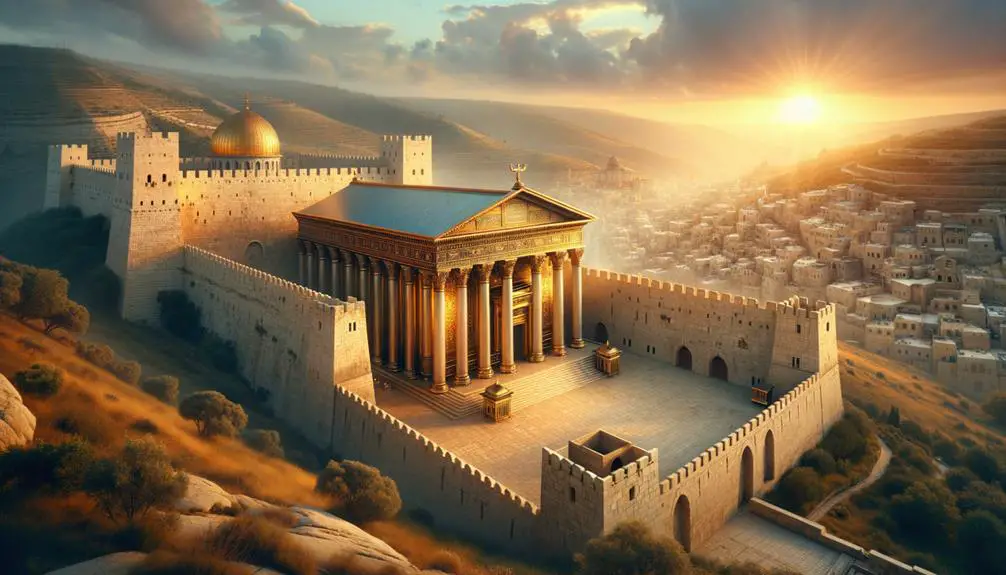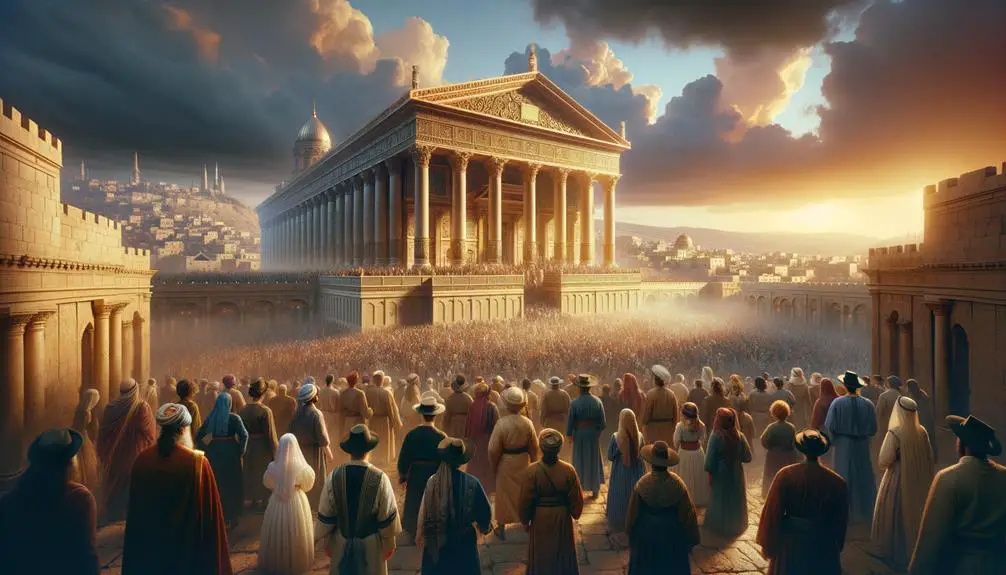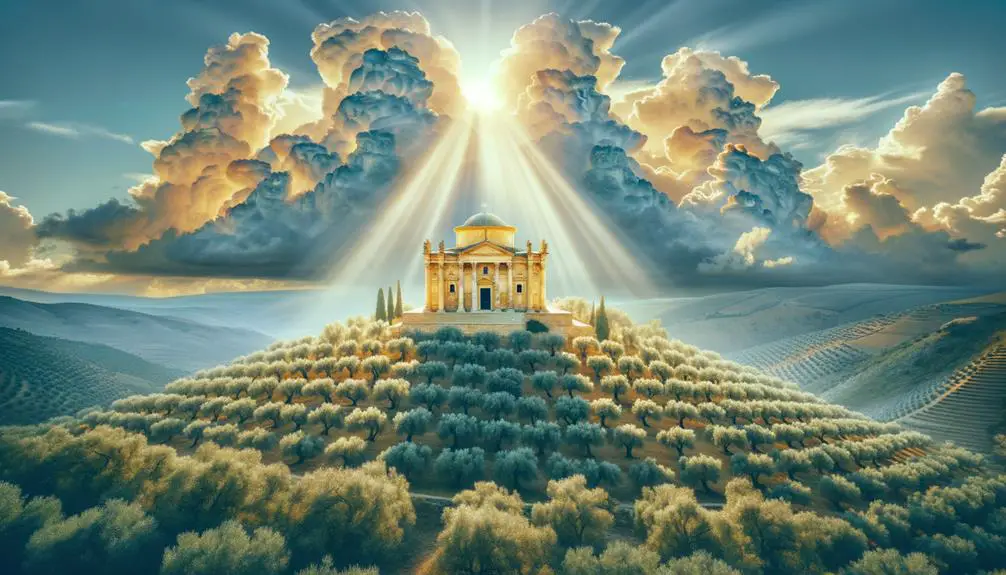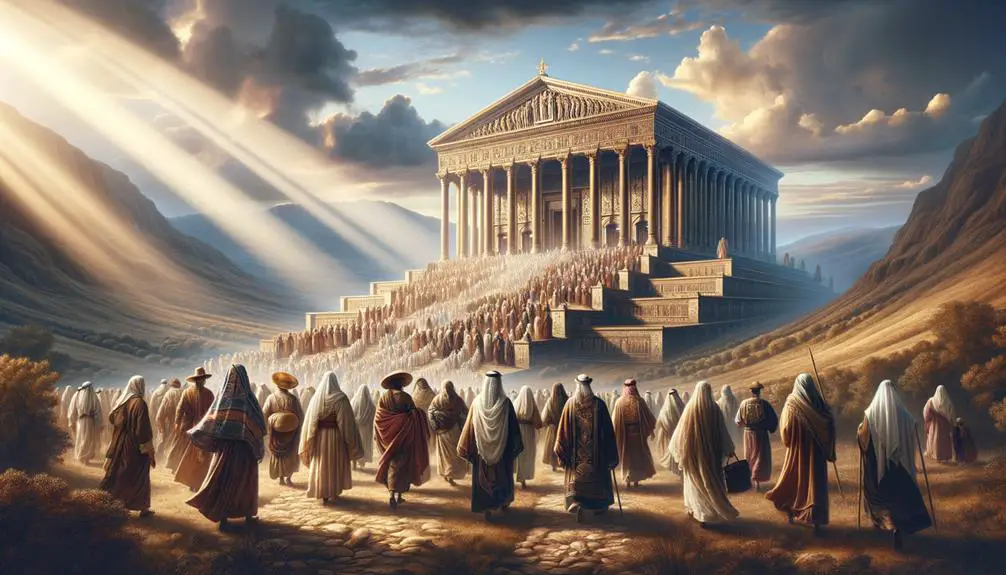Charting the temple's biblical journey reveals hidden layers of spiritual significance, inviting a deeper exploration into its sacred mysteries.

What Is the Temple in the Bible
The temple in the Bible stands as a lighthouse, guiding the faithful through centuries of spiritual tempests. You'll find its roots deeply embedded in historical foundations, its structure resonating with architectural marvels, and its essence woven with profound spiritual symbolism.
As you explore its ceremonial functions and sift through the layers of biblical references and interpretations, you'll unearth a treasure trove of insights. But to truly grasp its significance, you must venture beyond the surface.
Let's embark on this journey together, where each stone and scripture reveals a story waiting to be uncovered.
Key Takeaways
- The temple symbolizes the spiritual connection and divine presence central to ancient Israel's faith.
- It served as a religious, social, and political hub, reflecting national identity and divine worship.
- Biblical references and ceremonies underscore its significance in religious rites, festivals, and daily worship.
- New Testament reinterpretations expand the temple's concept to embody the Christian community and individual believers as God's dwelling place.
Historical Foundations

In examining the historical foundations of the temple in the biblical narrative, it's crucial to recognize its role as not only a religious symbol but also a pivotal center for social and political life in ancient Israel. The temple's establishment marked a defining moment, reflecting both divine worship and the consolidation of national identity. However, its construction wasn't without significant challenges, deeply influenced by its geographic location.
You'll find that the geographic location of the temple, perched on Mount Moriah in Jerusalem, presented a unique set of difficulties. This location wasn't chosen arbitrarily; it held profound religious significance, believed to be the site where Abraham was to sacrifice Isaac. Yet, the rugged terrain and limited space on the mountaintop necessitated innovative architectural solutions. The builders had to embark on an extensive terracing project, creating a flat platform by cutting into rock and filling areas with earth and stones. This endeavor required not just tremendous manpower but also a sophisticated understanding of engineering and logistics, a testament to the ingenuity of ancient Israelite society.
Moreover, the construction of the temple faced logistical hurdles, from securing the necessary materials to the transportation of these resources across great distances. Materials like cedar wood and fine stones had to be imported from afar, involving intricate trade agreements with neighboring kingdoms. This aspect of the temple's construction underscores the complex interplay between religious devotion, political diplomacy, and economic strategies, highlighting the temple's role in broader regional dynamics beyond its immediate religious function.
Architectural Significance
How does the architectural design of the temple not only reflect its religious purpose but also embody the technological and artistic achievements of ancient Israelite society? The temple's architecture serves as a testament to the sophistication and ingenuity of ancient construction techniques, providing modern parallels that underscore its enduring influence.
The architectural significance of the temple can be analyzed through several key aspects:
- Materials and Resources: The choice and procurement of materials, such as cedar wood from Lebanon and fine gold for overlay, demonstrate advanced logistical capabilities and international trade relations.
- Construction Techniques: The use of stone and timber, crafted with precision and care, highlights not only the technical skill of ancient builders but also their ability to create a structure that would endure for centuries.
- Artistic Detailing: The intricate carvings and decorative elements, from cherubim to palm trees, reflect a deep artistic vision that integrates religious symbolism with aesthetic beauty.
- Engineering Innovations: The temple's layout and design, including its system for managing water and lighting, showcase early engineering innovations that have parallels in modern architectural practices.
- Cultural Representation: The architectural elements of the temple encapsulate the cultural and religious identity of ancient Israel, serving as a physical manifestation of their spiritual beliefs and societal values.
In analyzing the temple's architectural significance, it becomes clear that its design wasn't merely functional but also a profound expression of ancient Israelite religion, art, and technology. The temple stands as a monumental achievement, bridging the gap between the past and present through its enduring architectural legacy.
Spiritual Symbolism

Beyond its architectural grandeur, the temple also serves as a profound symbol of spiritual connection and divine presence for the ancient Israelite community. This eternal dwelling isn't just a physical structure; it embodies the very essence of the covenant between God and His people. You see, the temple stands as a testament to the divine presence, a space where heaven and earth are believed to intersect, offering a tangible point of contact with the divine.
In analyzing its spiritual symbolism, one must recognize the temple as a microcosm of the universe, designed to reflect cosmic order and harmony. It's not merely a building but a representation of theological and spiritual truths. The innermost sanctuary, the Holy of Holies, where the Ark of the Covenant was kept, symbolizes God's unapproachable holiness and the awe-inspiring mystery of the divine presence. This sacred space underscores the idea that God dwells among His people, yet remains set apart.
Moreover, the temple's elaborate design and orientation towards Jerusalem speak volumes about its role as a focal point for worship and spiritual pilgrimage. It serves as a constant reminder of God's promise to always be with His people, guiding and protecting them. The temple, therefore, isn't just an ancient relic; it's a powerful symbol of faith, hope, and eternal connection to the divine.
As you delve deeper into its layers of meaning, you'll find that the temple encapsulates the very heart of spiritual longing and divine pursuit, marking a space where the human and divine coalesce.
Ceremonial Functions
Delving into the ceremonial functions of the temple reveals its role as the epicenter of religious rites and festivals, embodying the community's spiritual rhythm and devotion. This sacred space served not only as a physical location for worship but also as a vibrant center for the enactment of a detailed liturgy, which included sacrificial offerings and the wearing of priestly garments. These elements weren't mere religious formalities but were imbued with profound symbolism and a deep sense of reverence for the divine.
The temple's ceremonial functions can be summarized as follows:
- Sacrificial Offerings: Central to temple worship, these offerings ranged from animals to grains, symbolizing atonement, thanksgiving, and covenant renewal between the people and God.
- Priestly Garments: Worn by priests during rituals, these elaborate outfits symbolized purity, holiness, and the mediatory role of the priesthood.
- Festivals: The temple hosted major religious festivals, such as Passover and Yom Kippur, which drew pilgrims from across the land to participate in communal worship.
- Daily Prayers: It was the focal point for daily prayers, with morning and evening services that structured the spiritual life of the community.
- Purification Rites: Various ceremonies for purification were conducted within its precincts, reinforcing the temple's role in maintaining the community's ritual cleanliness.
Analyzing the ceremonial functions of the temple highlights its significance not just as a physical structure but as a living embodiment of the community's faith and devotion. Through sacrificial offerings, the donning of priestly garments, and the observance of sacred festivals, the temple facilitated an ongoing dialogue between the divine and the devout.
Biblical References and Interpretations

Throughout the Bible, numerous passages offer deep insights into the temple's significance, framing it as both a literal and metaphorical bridge between humanity and the divine. The Scriptures detail various temple locations, from the wilderness tabernacle in Exodus to Solomon's grand temple in Jerusalem, each serving as a focal point for God's presence and people's worship. These locations aren't merely historical footnotes; they embody the shifting landscape of divine-human interaction across the biblical narrative.
In exploring these sacred spaces, you'll find the temple's prophetic roles take center stage. Prophets like Isaiah and Jeremiah didn't just see the temple as a place of ritual but as a symbol of God's covenant with Israel—a covenant marked by fidelity and infidelity. Their messages, steeped in warnings and hope, illustrate the temple's role as a signpost pointing towards God's ultimate intentions for restoration and reconciliation.
Moreover, the New Testament reinterprets the temple's meaning, particularly in Jesus' ministry and the writings of Paul. Jesus' declaration of himself as the temple (John 2:19-21) and Paul's identification of the Christian community as the temple of the Holy Spirit (1 Corinthians 3:16) expand the concept beyond a physical location to a living, breathing community in relationship with God.
This detailed tapestry of biblical references and interpretations invites you to see the temple not just as an ancient relic but as a dynamic, multi-layered symbol of God's ongoing work in the world. It beckons you to delve deeper into the Scriptures, uncovering the rich, complex relationship between God, humanity, and the sacred spaces that bridge the two.
Frequently Asked Questions
How Has the Concept of the Temple Evolved in Modern Religious Practices Outside of Judaism and Christianity?
In modern religious practices, the temple concept has expanded beyond traditional boundaries.
You'll find that temple tourism has surged, with people seeking spiritual experiences in architecturally symbolic sites worldwide.
These structures often embody deep religious or philosophical meanings, adapting ancient traditions into contemporary contexts.
The evolution reflects a broader interpretation of sacred spaces, where architectural symbolism plays a crucial role in connecting individuals to spiritual or cultural heritage.
What Are the Environmental Impacts of Constructing Large Religious Structures Like the Ancient Temples, and How Are These Concerns Addressed Today?
Building grand religious structures, much like the ancient temples, impacts the environment significantly. Today, these concerns are tackled through green initiatives and the use of sustainable materials.
You're seeing a shift towards eco-conscious construction, minimizing the carbon footprint while preserving spiritual significance. This approach reflects a deeper understanding of stewardship over the earth, blending reverence for the divine with a commitment to environmental sustainability.
It's a thoughtful balance of tradition and modernity.
Can You Explain the Role and Significance of the Temple in Religious Texts Outside the Bible, Such as the Quran or the Bhagavad Gita?
You'll find that temples hold profound significance in texts like the Quran and the Bhagavad Gita, though in different contexts. The Quranic parallels often emphasize spiritual rather than physical realms, focusing on the mosque's role as a community and spiritual center.
Meanwhile, Gita philosophy illustrates the body as a temple, advocating for inner purity and devotion. Both perspectives offer deep insights into the role of sacred spaces in guiding moral and spiritual life.
How Do Contemporary Archaeological Methods Contribute to Our Understanding of the Temple's Original Location and Structure, and What Controversies Have Arisen From These Findings?
Today's tools, like radiocarbon dating and stratigraphy, shine a spotlight on the temple's timeline and terrain. These methods meticulously map out ancient architectures, bringing bones and bricks back to life.
However, artifact controversies occasionally cloud these clear-cut conclusions, sparking spirited scholarly debates. You're witnessing a dynamic dialogue where dating techniques dissect, detail, and sometimes dispute the temple's true tales, offering an analytical adventure into archaeology's heart.
In What Ways Have Artists and Musicians Been Inspired by the Temple to Create Works of Art, and How Do These Interpretations Compare to Its Biblical Descriptions?
You've seen artists and musicians draw heavily on temple symbolism, using artistic license to interpret its biblical essence creatively.
Their works often juxtapose or blend historical accuracy with personal or cultural reflections, offering a diverse spectrum of interpretations.
Comparing these to the temple's biblical descriptions, you'll find variations in accuracy but a shared reverence and inspiration.
This artistic freedom enriches our understanding, presenting the temple in new, imaginative lights.
Conclusion
So, after delving deep into the historical roots, marveling at the architectural grandeur, unpacking layers of spiritual symbolism, and navigating the ceremonial intricacies of the temple as depicted in the Bible, you'd think we'd have it all figured out, right?
Ironically, the more we learn, the more we realize the temple isn't just a building or a relic of the past. It's a complex metaphor, continuously reinterpreted, challenging our understanding of the divine and the human connection.
It's a scholarly puzzle, forever inviting analysis yet resisting definitive conclusions.



Sign up